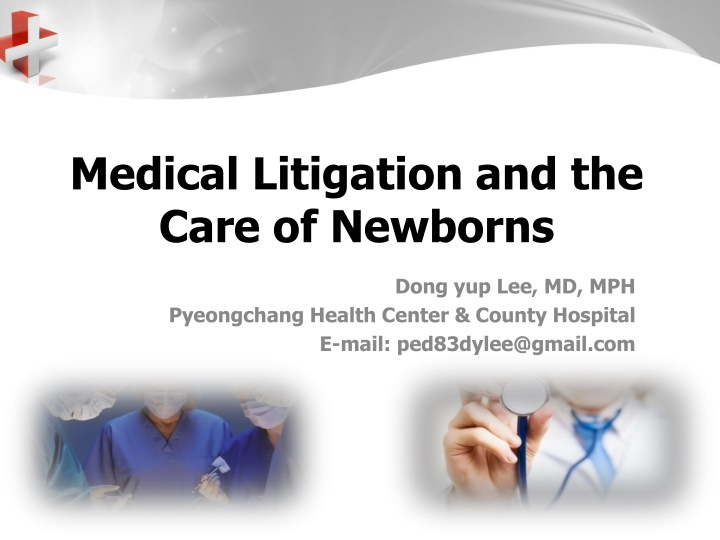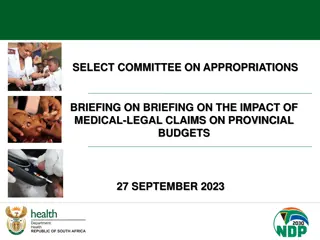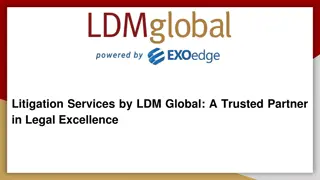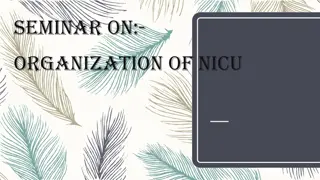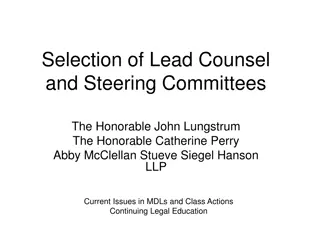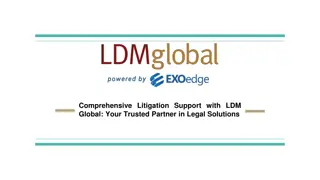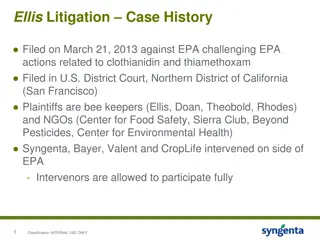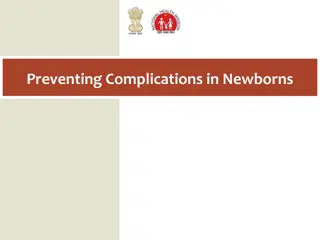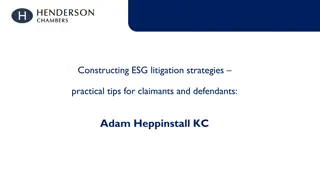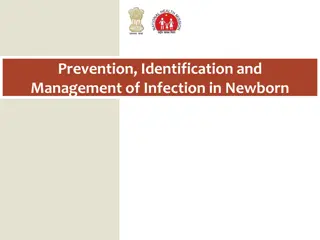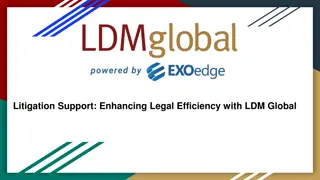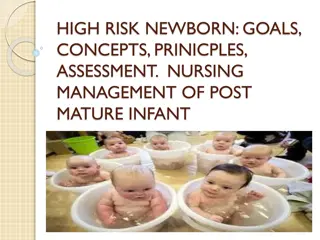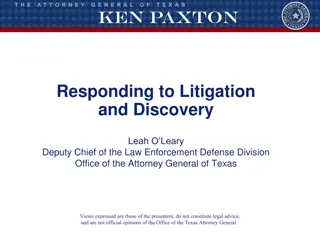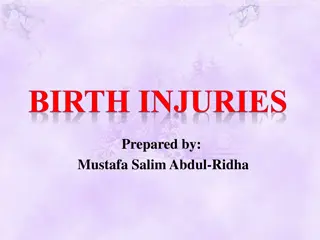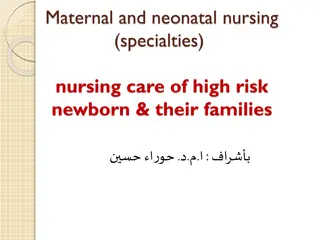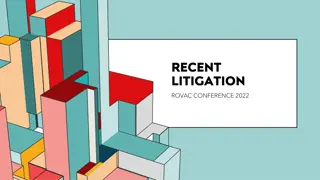Medical Litigation and Care of Newborns: Causes, Characteristics, and Solutions
The study focuses on the analysis of medical litigation precedents in neonatal care to identify causes and propose solutions to reduce medical malpractice in high-risk pregnancy and newborn care. It explores the impact of increased medical disputes and the potential risk factors for medical accidents in newborns.
Download Presentation

Please find below an Image/Link to download the presentation.
The content on the website is provided AS IS for your information and personal use only. It may not be sold, licensed, or shared on other websites without obtaining consent from the author.If you encounter any issues during the download, it is possible that the publisher has removed the file from their server.
You are allowed to download the files provided on this website for personal or commercial use, subject to the condition that they are used lawfully. All files are the property of their respective owners.
The content on the website is provided AS IS for your information and personal use only. It may not be sold, licensed, or shared on other websites without obtaining consent from the author.
E N D
Presentation Transcript
Medical Litigation and the Care of Newborns Dong yup Lee, MD, MPH Pyeongchang Health Center & County Hospital E-mail: ped83dylee@gmail.com
Increasing medical disputes Cases of Medial Litigation Cases of Medial Disputes 806 1000 617 1101 421 1009 979 500 911 755 0 2012 2013 2014 519 Data from the Korea Consumer Agency 1895 2000 1691 1398 1500 1000 2000 2003 2006 2009 2012 2013 503 500 Data from the Judicial Yearbook 0 2012 2013 2014 2015 Data from the Korea Medical Dispute Mediation and Arbitration Agency
Process of medical disputes Medical disputes Medical accidents Medical service use Medical litigation Disputes mediation organization Mutual agreement
Effect of increased medical litigation If medical ligation Defensive medicine Avoiding a department with frequent medical disputes Excessive diagnostic test and treatment Shortage of medical professionals in particular department Health care costs Medical approachability Patient's financial burden Negative impacts on patients
Purpose of study High risk pregnancy Newborn? The first 4weeks after birth Many physiological changes occur Very vulnerable and unstable 2/3 of infants death here Potential risk factor for medical accidents Preterm birth Low birth weight baby Chromosomal anomaly Congenital malformation If this trend continues? Medical disputes will increase Purpose of this study? To identify the causes and characteristics of medical litigation through the analysis of precedents in neonatal area To propose measures in order to reduce medical malpractice
Definition of terms Medical accidents Medical malpractice Medical disputes Medical accidents Unexpected results in medical act A value neural term Medical accident caused by negligence of doctors A legal term Conflicts between doctors and patients due to medical accident Medical malpractice Duty of care Duty of explanation Obligation of the medical personnel to make efforts to prevent patients physical or mental harm 1. To recognize the outcome in advance Obligation to explain all the means of treatment, the risks, diagnosis and prognosis To satisfy the patient s right to know 2. To take action for avoiding a bad outcome
Variables 1.Death 2.Disability 3.Recovery 04 28 cases of precedents Outcome of medical accident 2005-2009, for 5 years 1.Violation of the duty of care 2.Violation of the duty of explanation Interval from the time of the incident to the end of the litigation 05 01Duration of the medical litigation Types of violation of duty Amount of compensation for damage 06 02Birth weight and gestational age 1.Plaintiffs win (including partial win) 2.Plaintiffs lost 3.Reconciliation Categorized based on the main symptoms 07 Disease classification 03 Final court result
Results Duration of the medical litigation? 4.4 year VS Preterm infant rate 32.1% 5.7% 100% No data 80% Gestational age 60% 40% Preterm baby Full term baby Average gestational age All newborn in study 35.3weeks Preterm baby in study (9 cases) 31.9weeks 20% 0% Study National average Low birth weight infant rate 28.6% 4.9% VS 100% Birth weight No data 80% 60% Average birth weight All newborn in study 2.7kg Low birth weight baby in study (8 cases) 1.6kg 40% Low birth weight Normal 20% 0% Study National average from Lee et al. Neonatal Med 2015 February;22(1):1-7.
Results Final court results Reconcili ation, 6 Types of violation of duty 10 Violation of the duty of care 11 Plaintiffs won, 12 Violation of the duty of care and explanation Violation of the duty of explanation 1 Plaintiffs lost, 10 1 Amount of compensation for damage Outcomes of medical accidents 11 KRW161,389,291 $136,000 4 10 12 Death outcome cases KRW 86,772,582 Disability outcome cases KRW 208,872,650 Death Blindness Skin necrosis Cerebral palsy Hearing loss
Results Total 28cases Neurological diseases Gastrointestinal diseases 5cases(17.9%) 6cases(21.4%) Pulmonary diseases Aspiration accidents 4cases(14.3%) 5cases(17.9%) Ophthalmic diseases Infectious diseases 2cases(7.1%) 4cases(14.3%) Drug associated accident Otorhinolaryngologic diseases 1cases(3.6%) 1cases(3.6%)
Group1 Gastrointestinal diseases Reconcili ation, 1 Total 6 cases Plaintiffs won , 3 Necrotizing enterocolitis (4 cases) Severe dehydration due to diarrhea, vomiting and bloody stool (2 cases) Plaintiffs lost, 2 From 2005 to 2009, among 28 cases Real case Features - IUP 36weeks, 2.9kg, 7thday - Due to diarrhea, bloody stool No Symptom or mild symptoms Weight, intake, excretion and basic vital signs must be measured Warning sign : weight loss beyond the degree of postnatal physiological weight loss (less than 10%) - Vital signs, weight and I/O not checked - After 2days, symptoms got worse - Transferred to a university hospital - Died of sepsis, 2.34kg - 0.56kg(19.3%) weight loss
Group2 Neurological diseases Total 5cases Hypoxic ischemic brain injury, Convulsion (3cases) Reconcil iation, 1 Nuclear jaundice due to hemolytic disease of newborns(2cases) Plaintiffs won , 2 Plaintiffs lost, 2 From 2005 to 2009, among 28 cases [Treatment] 1. Exchange transfusion 2. Intensive phototherapy Real case Features Two cases of nuclear jaundice Newborn hemolytic disease Standard of judgment? Whether doctors made efforts to control convulsions and prevent it from recurring Total bilirubin levels - Case 1: 19mg/dl at 1stday - Case 2: 61mg/dl at 3rdday It should be considered to transfer patients if facilities are not adequate for the best treatment Patients were not transferred immediately Exchange transfusion timing was delayed
Group3 Pulmonary diseases Reconcili ation, 1 Total 4cases Hyaline membrane disease(2cases) Plaintiffs lost, 3 Pneumothorax (1case) Meconium aspiration(1case) From 2005 to 2009, among 28 cases Features Patient factors Other factors No case plaintiffs won - Treatment methods (medicine, nutrition etc.) - Treatment equipments - Doctor s decision making - Disease severity - Immaturity of newborn lung - Weight, age Respiratory distress symptoms were aggravated shortly after birth or within hours
Group4 Ophthalmic diseases plaintiffs won, 2 Reconcili ation, 2 40 35.3 2.7 3 31.9 35 29.2 1.6 2 1.2 30 1 25 20 0 From 2005 to 2009, among 28 cases Gestational age(weeks) All cases preterm cases ophthalmic cases Birth weight(kg) All cases preterm cases ophthalmic cases Total 4 cases Retinopathy of prematurity(ROP) Risk factor Controllability How to deal with ROP Gestational age Birth weight Immaturity of retina Long term, high density oxygen therapy Check up regularly to see if it is going to ROP Uncontrollable Controllable Use only as little as oxygen needs
Group5 Aspiration accidents Reconcili ation, 1 Total 5 cases Invasive procedure immediately after feeding (3cases) Insufficient belching (2cases) Plaintiffs won , 4 From 2005 to 2009, among 28 cases Features Aspiration of stomach contents by vomiting or reflux Regurgitation easily happen in neonate Belch after feeding Avoid invasive procedure after feeding Check the last feeding time before procedure To ensure enough time has passed for the stomach contents to be emptied.
Others Otorhinolary ngologic disease, 1 Infectious diseases, 2 Drug associated accident , 1 From 2005 to 2009, among 28 cases Infectious diseases (2cases) 1 plaintiffs won 1 plaintiffs lost Drug associated accident (1case) plaintiffs lost Otorhinolaryngologic disease (1case) plaintiffs lost Meningitis, sepsis by Group B streptococcus infection Myocarditis, encephalitis by enterovirus infection Skin necrosis due to extravasation of calcium Sensory hearing loss after use ototoxic antibiotics
The yardstick of judgment Outcome Process Nobody can blame a doctor why he didn t choose treatment A Option A, B Reasonable choices based on current medical standard of care A B Bad results Option C Unreasonable choice C Option Outcome Process Judgment Reasonable choice Unreasonable choice B Medical accident. Responsibility (X) Unwanted Results C Medical malpractice. Responsibility (O)
Limitations 01 Impossible to analyze the contents not in the written judgment 02 Decisions from a non-specialist in the medical field Only for the part requested by the patient Possible to miss important clues 03 Frequent cases in medical litigation Not represent cases in real medical field
Take home message To prevent medical malpractice 01 Fulfill duty of care and explanation Inadequate facilities for treatment Consider transfer patients to a higher level hospital 02 Uncontrollable diseases Regularly check patients to detect worsening of diseases 03 Treatment in accordance with the clinical practice guidelines Best way to protect patients and defend doctors themselves from medical accidents 04
Questions & Answers Thank you for your attention. Dong yup Lee, MD, MPH Pyeongchang Health Center & County Hospital E-mail: ped83dylee@gmail.com
